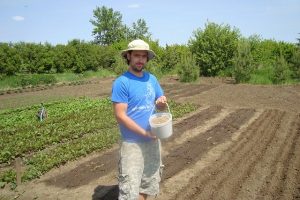Courtesy of Wally S., Wally’s Urban Market Garden, Pleasantdale SK
The planning questions keep coming, and last week the big one was, “How do I know if a crop is worth growing?” Getting an accurate read on your seed costs is a big part of the answer. In fact, knowing the cost to seed a bed is make or break in planning.
To get an accurate read on your seed costs, you need to determine your seeding rate per bed. To do that, you need to determine the following for the crop in question:
> # of rows per bed
> width of each row
> in-row spacing
> # of seed required per row
> # of seed required per bed
Using benchmarks from SPIN’s Crop Profiles, let’s look at carrots as an example.
> # of rows per standard size bed: 3
> width of each row: 2”
> in-row spacing: 12” apart; 30 seeds per foot
> # of seed required per row: 750 seeds
> # of seed required per bed: 1,125
Next, using the seed cost stats from SPIN’s Crop Profiles, look at what seed costs look like:
> typical cost per 25M quantities: $20 – $40
> cost to seed a bed: $2 per bed for the most expensive varieties
If you use SPIN’s revenue target of $100 per bed, you can see the seed cost per bed is way less than the revenue per bed. And in fact, some types of carrots can generate revenue of close to $200 per bed. So now you can see why SPIN categorizes carrots as a very high value crop.
Do the same calculations for more expensive sprouting microgreens seed, and you could start to see costs of up to $20 to seed a bed. Factoring in other costs and your labor, you need to determine when the answer to, “Is a crop worth growing?” is “No.”
There are lots of variables that can come into play too. You can tweak your seeding rate, raise your prices, or negotiate seed costs. But as with all businesses, at the end of the day it comes down knowing what calculations to make. Seeding rate is an important, but overlooked one.

You’ll get a feel for the amount of seed you need to use after a few trial plantings. The goal is to figure out the minimum amount of seed you need in order to achieve your targeted yield. Â And then record that rate and figure out the cost to seed a bed. Â
GET MORE SEED BUYING SAVVY WHEN YOU PURCHASE OUR LEARNING PROGRAM ON TURNING SMALL PLOTS INTO CASH HERE.
NOT READY TO GO ALL-IN YET, GET A TASTE OF WHAT THE BACKYARD FARMING BUSINESS IS LIKE IN OUR MEMBERSHIP GROUP. YOU CAN JOIN IT HERE.


